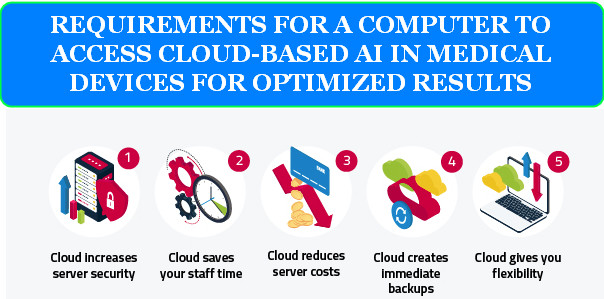
To ensure high accuracy, speed, and reliability when interfacing with cloud-based AI in medical devices, the accessing computer must meet specific hardware, software, and network requirements. Below are the key technical and operational specifications needed to optimize performance and prevent errors.
1. HARDWARE REQUIREMENTS
A) PROCESSING POWER
· Minimum: Multi-core CPU (Intel i5 / AMD Ryzen 5 or equivalent)
· Recommended: High-performance CPU (Intel i7/i9, AMD Ryzen 7/9, or Xeon) for real-time data processing
· GPU Acceleration:
o NVIDIA RTX 3060+ or AMD Radeon RX 6700+ for AI-assisted medical imaging
o CUDA cores / Tensor cores for deep learning inference
B) MEMORY (RAM)
· Minimum: 8GB RAM
· Recommended: 16GB–32GB (for large datasets, e.g., radiology AI)
· Critical for: Running local pre-processing before cloud submission
C) STORAGE
· SSD (NVMe preferred) for fast read/write speeds (≥500GB)
· Redundant backup storage for patient data logs
2. SOFTWARE & OPERATING SYSTEM REQUIREMENTS
A) OS COMPATIBILITY
· Windows 10/11 (64-bit), macOS 12+, or Linux (Ubuntu LTS preferred)
· Real-time OS (RTOS) support if used in critical care devices
B) SECURE & VALIDATED SOFTWARE STACK
· Encrypted communication libraries (TLS 1.3, OpenSSL)
· Containerized environments (Docker, Kubernetes) for reproducible AI execution
· Medical-grade software certification (IEC 62304 compliance)
C) AI FRAMEWORK SUPPORT
· TensorFlow Lite, ONNX Runtime, or PyTorch for edge-cloud hybrid processing
· API integration with major cloud AI providers (AWS HealthLake, Google Cloud Healthcare API)
3. NETWORK & CONNECTIVITY REQUIREMENTS
A) HIGH-SPEED INTERNET
· Minimum: 50 Mbps upload/download (for real-time diagnostics)
· Recommended: Fiber-optic / 5G connection (for high-resolution imaging)
B) LOW LATENCY & QOS (QUALITY OF SERVICE)
· <100ms latency for critical applications (e.g., remote surgery assistance)
· Dedicated VPN / MPLS for secure hospital networks
C) REDUNDANCY & FAILOVER
· Dual-WAN / 4G/5G backup to prevent disconnections
· Edge caching for frequently used AI models
4. SECURITY & COMPLIANCE REQUIREMENTS
A) DATA PROTECTION
· End-to-end encryption (AES-256)
· HIPAA / GDPR compliance for patient data
B) ACCESS CONTROL
· Biometric / hardware-based authentication (e.g., YubiKey, TPM 2.0)
· Role-based access control (RBAC) for medical staff
C) AUDIT & LOGGING
· Immutable logs of all AI interactions
· Explainable AI (XAI) reports for regulatory audits
5. OPTIMIZATION TECHNIQUES FOR BEST PERFORMANCE
A) LOCAL PRE-PROCESSING
· Noise reduction, data compression before cloud upload
· Edge AI filtering (e.g., running a lightweight model locally before cloud submission)
B) ADAPTIVE AI MODEL SELECTION
· Dynamic model switching based on network conditions
· Federated learning for privacy-preserving updates
C) CONTINUOUS MONITORING
· Real-time performance metrics (latency, accuracy drift detection)
· Automated alerts if cloud AI results deviate from expected ranges
CONCLUSION
To optimize cloud-based AI medical device interactions, the accessing computer must have:
✅ High-performance CPU/GPU & fast storage
✅ Secure, low-latency networking
✅ Medical-compliant software stack
✅ Redundant failover mechanisms
By meeting these requirements, hospitals and clinics can maximize AI accuracy while minimizing risks of delays or errors

